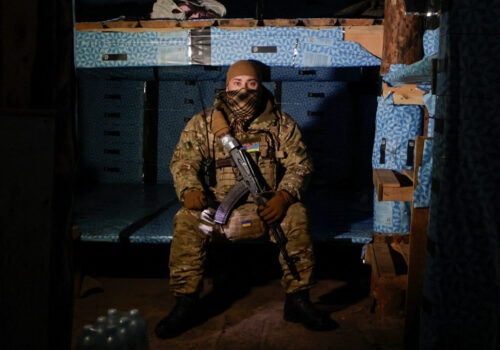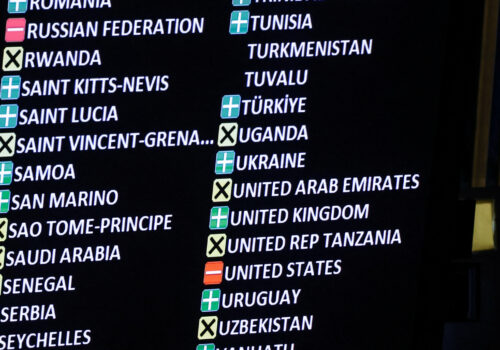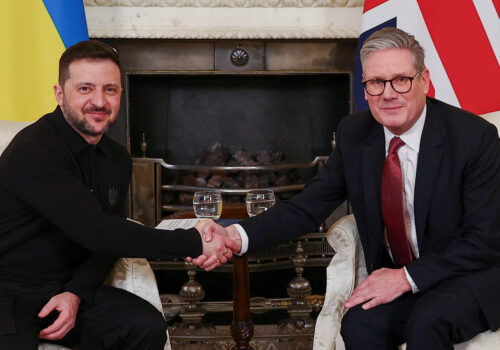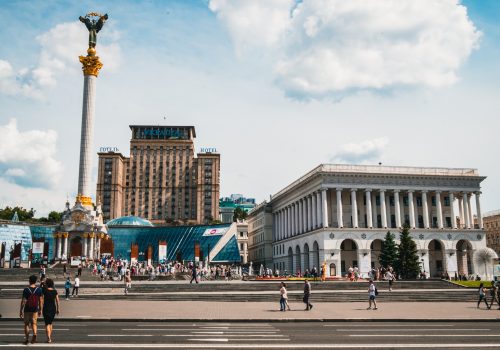JUST IN
Progress for peace or stalling tactic? On Tuesday, after a ninety-minute phone call with US President Donald Trump, Russian President Vladimir Putin agreed to refrain from attacking Ukrainian energy infrastructure for thirty days. However, Putin did not commit to a full, unconditional thirty-day cease-fire, which Washington and Kyiv agreed to last week. He also repeated his earlier demand that Ukraine must stop receiving foreign military aid. What does the phone call mean for the war? And what are the next steps in US talks with Russia and Ukraine? Our experts make their calls below.
TODAY’S EXPERT REACTION BROUGHT TO YOU BY
- John E. Herbst (@JohnEdHerbst): Senior director of the Eurasia Center and former US ambassador to Ukraine
- Olga Khakova (@OlgaKhakova): Deputy director for European energy security at the Global Energy Center
- Alexander “Sandy” Vershbow (@ARVershbow): Distinguished fellow at the Scowcroft Center for Strategy and Security and the Eurasia Center, and a former US ambassador to NATO and Russia
- Justina Budginaite-Froehly (@JustBudginaite): Nonresident senior fellow at the Scowcroft Center’s Transatlantic Security Initiative and the Europe Center, as well as a former official in the Lithuanian Ministry of Defense
What Putin agreed to
- “It is a good day for President Trump,” John tells us, “because this is the first time that Moscow has offered a concrete concession in response to his peace initiative.” It may be “a small step forward toward ending the Kremlin’s aggression in Ukraine.” At the same time, John notes that the deal “may already be moot,” as within an hour of the announcement a Russian bomb reportedly took out the power in the Ukrainian city of Slovyansk.
- If the thirty-day limited cease-fire nonetheless holds, it “could provide a much needed reprieve for the battered energy sector in Ukraine,” Olga explains, as Russia has already destroyed “more than half of Ukraine’s generation capacity and half of its natural gas production capabilities.” But it’s also unclear what this deal might mean for the Russian-occupied Zaporizhzhia nuclear power plant, and it cannot replace the destruction of the Kakhovka Dam in 2023.
- Putin likely made the deal with Russian energy infrastructure front of mind. “This is the one area where a cease-fire would benefit Russia more than Ukraine, given Kyiv’s expanding capacity for long-range drone attacks on Russian energy targets,” says Sandy.
Sign up to receive rapid insight in your inbox from Atlantic Council experts on global events as they unfold.
Russia negotiations 101
- “Putin is in no hurry to reach a longer-term cease-fire, much less a permanent peace agreement,” says Sandy. The Russian president has repeatedly underscored that any agreement must address the “root causes” of the conflict—by which he means NATO—and the readout from the meeting is packed with “conditions, caveats, and poison pills for cease-fire negotiations that Ukraine is certain to reject,” he adds.
- “Any curtailment in Russia’s brutal aggression is a step in the right direction—but this development takes place against Russia’s continued missile attacks on Ukrainian civilians and on hospitals,” Olga adds.
- Meanwhile, Justina notes, front-line countries are not convinced that Putin is stopping anytime soon: The defense ministers of Poland, Lithuania, Latvia, and Estonia today announced their plan to pull out of the Ottawa Convention preventing the use of anti-personnel landmines. “With this decision, they are signaling their readiness to defend their territories from potential Russian aggression by all means,” she says.
A real cease-fire?
- Next, Putin and Trump agreed to seek a cease-fire in the Black Sea. “This is another area where a cease-fire—still to be worked out—is not a disadvantage to the Kremlin,” John points out. “Ukraine’s ingenious naval drone operations drove Russia’s vaunted Black Sea fleet out of Crimea over a year ago to refuge in the eastern Black Sea.”
- Even as talks proceed, Washington will need to watch for violations of the existing agreement. If Russia does attack Ukrainian energy infrastructure, then “the United States must showcase strength by forcing Russia to the table through additional export controls and sanctions on Russia’s oil and gas and on its financial system,” Olga says.
- Throughout this process, Russia’s foot-dragging and incremental approach will pose a challenge for US negotiators. “The danger lies in the United States becoming increasingly entangled in Putin’s strategy, ultimately finding it difficult to adhere to its original plan for inclusive peace negotiations,” Justina says.
- “Putin evidently doesn’t want to say ‘no’ to Donald Trump, but his demands are the Russian leader’s way of rejecting the proposal without saying so,” Sandy tells us. “Hopefully, Trump will not accept ‘no’ for an answer and will continue to insist that Russia agree to a full cease-fire as originally proposed—on the Black Sea, on land, and in the air.”
The post The real meaning of Putin’s 30-day ‘energy cease-fire’ in Ukraine appeared first on Atlantic Council.
















